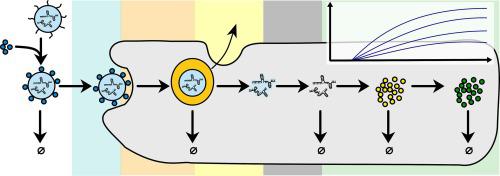当前位置:
X-MOL 学术
›
Eur. J. Pharm. Biopharm.
›
论文详情
Our official English website, www.x-mol.net, welcomes your
feedback! (Note: you will need to create a separate account there.)
Kinetics of RNA-LNP delivery and protein expression
European Journal of Pharmaceutics and Biopharmaceutics ( IF 4.4 ) Pub Date : 2024-02-20 , DOI: 10.1016/j.ejpb.2024.114222 Judith A Müller 1 , Nathalie Schäffler 1 , Thomas Kellerer 2 , Gerlinde Schwake 1 , Thomas S Ligon 3 , Joachim O Rädler 1
European Journal of Pharmaceutics and Biopharmaceutics ( IF 4.4 ) Pub Date : 2024-02-20 , DOI: 10.1016/j.ejpb.2024.114222 Judith A Müller 1 , Nathalie Schäffler 1 , Thomas Kellerer 2 , Gerlinde Schwake 1 , Thomas S Ligon 3 , Joachim O Rädler 1
Affiliation

|
Lipid nanoparticles (LNPs) employing ionizable lipids are the most advanced technology for delivery of RNA, most notably mRNA, to cells. LNPs represent well-defined core–shell particles with efficient nucleic acid encapsulation, low immunogenicity and enhanced efficacy. While much is known about the structure and activity of LNPs, less attention is given to the timing of LNP uptake, cytosolic transfer and protein expression. However, LNP kinetics is a key factor determining delivery efficiency. Hence quantitative insight into the multi-cascaded pathway of LNPs is of interest to elucidate the mechanism of delivery. Here, we review experiments as well as theoretical modeling of the timing of LNP uptake, mRNA-release and protein expression. We describe LNP delivery as a sequence of stochastic transfer processes and review a mathematical model of subsequent protein translation from mRNA. We compile probabilities and numbers obtained from time resolved microscopy. Specifically, live-cell imaging on single cell arrays (LISCA) allows for high-throughput acquisition of thousands of individual GFP reporter expression time courses. The traces yield the distribution of mRNA life-times, expression rates and expression onset. Correlation analysis reveals an inverse dependence of gene expression efficiency and transfection onset-times. Finally, we discuss why timing of mRNA release is critical in the context of codelivery of multiple nucleic acid species as in the case of mRNA co-expression or CRISPR/Cas gene editing.
中文翻译:

RNA-LNP 递送和蛋白质表达的动力学
采用可电离脂质的脂质纳米颗粒 (LNP) 是将 RNA(尤其是 mRNA)递送至细胞的最先进技术。 LNP 代表明确的核壳颗粒,具有高效的核酸封装、低免疫原性和增强的功效。虽然人们对 LNP 的结构和活性了解甚多,但对 LNP 摄取、胞质转移和蛋白质表达的时间关注较少。然而,LNP 动力学是决定递送效率的关键因素。因此,定量了解 LNP 的多级联途径对于阐明递送机制很有意义。在这里,我们回顾了 LNP 摄取、mRNA 释放和蛋白质表达时间的实验和理论模型。我们将 LNP 递送描述为一系列随机转移过程,并回顾了随后从 mRNA 进行蛋白质翻译的数学模型。我们编译了从时间分辨显微镜获得的概率和数字。具体来说,单细胞阵列上的活细胞成像 (LISCA) 允许高通量采集数千个单独的 GFP 报告基因表达时间过程。这些痕迹产生了 mRNA 寿命、表达率和表达起始时间的分布。相关分析揭示了基因表达效率和转染起始时间的负相关性。最后,我们讨论了为什么 mRNA 释放的时机在多个核酸物种的共传递背景下至关重要,例如在 mRNA 共表达或 CRISPR/Cas 基因编辑的情况下。
更新日期:2024-02-20
中文翻译:

RNA-LNP 递送和蛋白质表达的动力学
采用可电离脂质的脂质纳米颗粒 (LNP) 是将 RNA(尤其是 mRNA)递送至细胞的最先进技术。 LNP 代表明确的核壳颗粒,具有高效的核酸封装、低免疫原性和增强的功效。虽然人们对 LNP 的结构和活性了解甚多,但对 LNP 摄取、胞质转移和蛋白质表达的时间关注较少。然而,LNP 动力学是决定递送效率的关键因素。因此,定量了解 LNP 的多级联途径对于阐明递送机制很有意义。在这里,我们回顾了 LNP 摄取、mRNA 释放和蛋白质表达时间的实验和理论模型。我们将 LNP 递送描述为一系列随机转移过程,并回顾了随后从 mRNA 进行蛋白质翻译的数学模型。我们编译了从时间分辨显微镜获得的概率和数字。具体来说,单细胞阵列上的活细胞成像 (LISCA) 允许高通量采集数千个单独的 GFP 报告基因表达时间过程。这些痕迹产生了 mRNA 寿命、表达率和表达起始时间的分布。相关分析揭示了基因表达效率和转染起始时间的负相关性。最后,我们讨论了为什么 mRNA 释放的时机在多个核酸物种的共传递背景下至关重要,例如在 mRNA 共表达或 CRISPR/Cas 基因编辑的情况下。











































 京公网安备 11010802027423号
京公网安备 11010802027423号